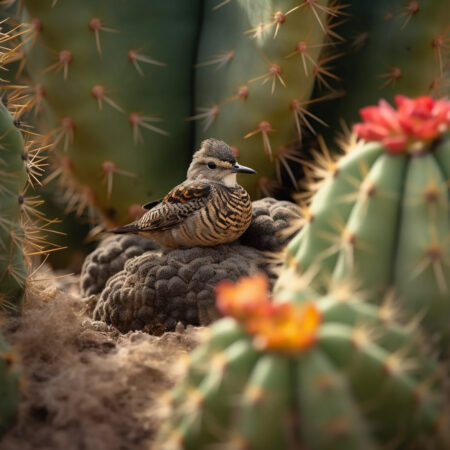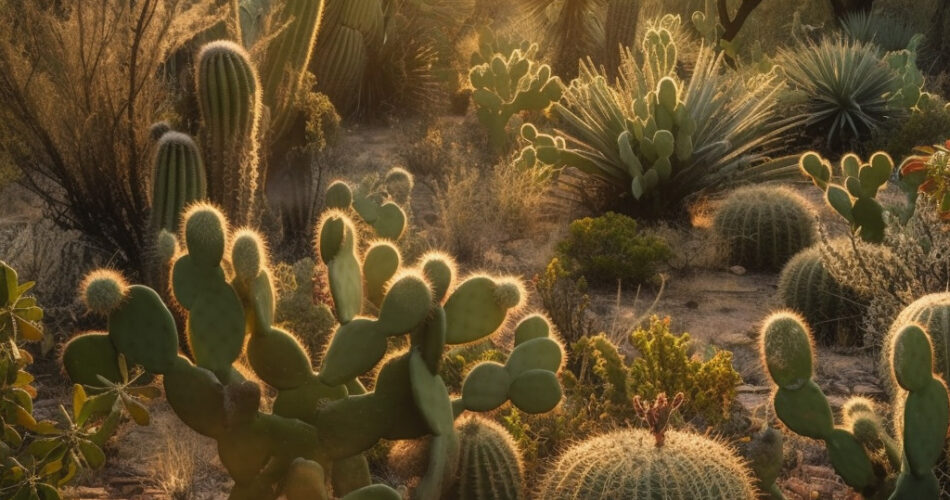Key Takeaways:
- Cacti play a vital role in ecosystems by providing shelter, food, and nesting opportunities for wildlife.
- Creating cactus-friendly wildlife habitats supports biodiversity, pest control, and enhances the aesthetic appeal of surroundings.
- Cacti and wildlife have a mutually beneficial relationship, with animals relying on cacti for nesting, shelter, and as a food source.
- Select the appropriate cactus species based on climate and soil conditions to create an optimal habitat.
- Design a habitat with well-drained soils and proper watering techniques for cacti.
- Incorporate native flora along with cacti to attract a diverse range of wildlife.
- Provide essential food sources, shelter, and nesting areas to attract wildlife to the habitat.
- Promote water conservation and implement sustainable gardening practices in the habitat.
- Monitor and control invasive species and educate others about the importance of wildlife habitats.
The Importance of Creating Cactus-Friendly Wildlife Habitats
Cacti are not only iconic plants of arid regions but also play a vital role in the ecosystems they inhabit. These hardy succulents have adapted to survive in harsh desert environments, providing shelter, food, and nesting opportunities for a wide range of wildlife. Creating cactus-friendly wildlife habitats is crucial for conserving biodiversity and supporting the natural balance of these unique ecosystems.
1. Understanding the Role of Cacti in Ecosystems
Cacti are often referred to as ecosystem engineers due to their ability to modify and create habitat for other organisms. Their spiny stems and branches provide shelter and protection for small animals, while their flowers attract pollinators such as bees, butterflies, and birds. Cacti also act as water storage tanks, efficiently conserving water during dry periods and providing a vital resource for wildlife during times of scarcity.
Furthermore, cacti create microclimates around themselves, offering shade and reducing soil erosion in their immediate vicinity. These microclimates provide favorable conditions for other plant species to grow, contributing to the overall diversity of the habitat.
2. The Benefits of Supporting Wildlife Habitats
Supporting wildlife habitats, particularly those that incorporate cacti, offers numerous benefits to both the environment and human communities. Firstly, it helps in preserving and conserving biodiversity. By providing suitable conditions for a variety of species to thrive, we ensure the continuation of ecological processes and the balance of ecosystems.
Cactus-friendly wildlife habitats also contribute to pest control. Many birds and insects that are attracted to cactus flowers feed on pests like aphids and scale insects, reducing the need for chemical pesticides in the area. This natural pest control mechanism protects the health of the ecosystem and reduces the potential risks associated with pesticide use.
Additionally, supporting wildlife habitats can enhance the aesthetic appeal of your surroundings. The beauty of cacti in bloom and the diversity of wildlife they attract create a visually stunning landscape that is enjoyable for both residents and visitors.
3. Exploring the Relationship Between Cacti and Wildlife
Cacti and wildlife have evolved a mutually beneficial relationship over millions of years. Many animals have adapted to rely on cacti for various aspects of their survival. For example, some bird species rely on specific cactus species for nesting, as the spiny structures provide protection from predators.
Moreover, numerous small mammals and reptiles seek shelter and refuge within the hollowed-out stems of certain cacti. These plant structures offer temperature regulation and a safe haven from predators in the harsh desert environment.
Cacti also serve as an important food source for wildlife. The nectar-rich flowers attract hummingbirds, bees, and butterflies, which play a vital role in pollination. Additionally, the fruits and seeds produced by cacti provide sustenance for a variety of animals, including desert-dwelling birds and rodents.

How to Design a Cactus-Friendly Wildlife Habitat
Designing a cactus-friendly wildlife habitat involves careful consideration of the needs of both the plants and the animals that depend on them. By following a few key principles, you can create an environment that supports a thriving ecosystem.
1. Selecting the Right Cactus Species for Your Habitat
Choosing the appropriate cactus species for your habitat is crucial for its long-term success. Consider the climate, soil conditions, and available space when selecting cacti. Native species are the most suitable choice as they have evolved to thrive in the specific environmental conditions of your region.
Research the growth habits and requirements of different cactus species to determine which ones are best suited for your habitat. Some cacti require full sun exposure, while others can tolerate partial shade. Understanding the needs of the plants will help create an optimal environment for their growth and survival.
2. Creating an Ideal Environment for Cacti to Thrive
Cacti thrive in well-drained soils, which mimic their natural desert habitats. Ensure your habitat has proper drainage to prevent waterlogging, as excess moisture can lead to root rot and other issues. Amending the soil with organic matter, such as compost, can improve its drainage capabilities.
Proper watering is critical for cacti. While they are adapted to survive in arid environments, they still require some watering to establish themselves. However, overwatering can be detrimental, so it’s essential to strike a balance. Water deeply but infrequently, allowing the soil to dry out between waterings.
3. Incorporating Native Flora to Attract Wildlife
In addition to cacti, incorporating native flora into your habitat will attract a diverse range of wildlife. Research the native plant species in your area and select those that provide food, shelter, and nesting opportunities for different types of animals.
Include a mix of flowering plants with staggered blooming periods to provide a continuous nectar source for pollinators. Native grasses, shrubs, and trees provide additional habitat elements, offering nesting sites, shelter from predators, and food sources for birds and small mammals.
Attracting Wildlife to Your Cactus Habitat
Creating a cactus-friendly wildlife habitat is not just about the cacti themselves; it’s also about attracting a diverse range of wildlife species to your garden. By providing the right conditions and resources, you can entice various animals to call your habitat home.
1. Providing Essential Food Sources for Wildlife
Installing bird feeders, butterfly plants, and native flowering plants ensures a steady food supply for wildlife. Different animal species have specific dietary requirements, so offering a variety of food sources will attract a broader range of wildlife.
For example, hummingbirds are attracted to nectar-rich flowers, while insects, such as butterflies, rely on plants that provide both nectar and host plants for their larvae. Research the preferred food sources of local wildlife and incorporate them into your habitat to encourage their presence.
2. Creating Shelter and Nesting Areas for Wildlife
Providing shelter and nesting opportunities is crucial for attracting wildlife to your cactus habitat. Cacti themselves offer shelter for small animals; however, incorporating other elements can provide additional refuge.
Installing birdhouses, bat boxes, and nest boxes can attract species that require specific nesting sites. Additionally, leaving fallen logs, rocks, or brush piles can provide hiding spots for reptiles, small mammals, and insects.
3. Promoting Water Conservation Practices in Your Habitat
Water scarcity is a significant issue in arid regions, so it’s important to promote water conservation in your cactus habitat. Implementing water-saving techniques such as drip irrigation or using rainwater collection systems can minimize water waste and ensure the availability of water for wildlife.
Providing shallow water sources, such as birdbaths or small ponds, can also attract various wildlife species that require water for drinking and bathing. Ensure that the water sources are cleaned regularly to prevent the spread of diseases.
Preserving and Maintaining Cactus-Friendly Wildlife Habitats
Preserving and maintaining cactus-friendly wildlife habitats requires ongoing effort and monitoring. By following a few key practices, you can ensure the long-term sustainability of your habitat.
1. Monitoring and Controlling Invasive Species
Invasive plant species can outcompete native flora and disrupt the delicate balance of a wildlife habitat. Regularly inspect your habitat for any signs of invasive species and take appropriate measures to control their spread.
Remove invasive plants manually or using environmentally friendly methods, ensuring that you do not disturb the surrounding ecosystem. Additionally, avoid introducing non-native species that may become invasive and pose a threat to native plant and animal populations.
2. Implementing Sustainable Gardening Practices
Practicing sustainable gardening techniques helps minimize the impact on the environment and supports the health of your cactus-friendly wildlife habitat. Use organic fertilizers and avoid the use of harmful pesticides, as they can harm beneficial insects and disrupt the natural balance.
Incorporate mulch around your cacti and other plants to conserve moisture, suppress weed growth, and reduce the need for watering. Mulch also acts as a thermal insulator, protecting the roots of the plants during extreme temperatures.
3. Educating Others About the Importance of Wildlife Habitats
Spread awareness about the importance of cactus-friendly wildlife habitats by educating others. Share your knowledge and experiences through social media, community workshops, or by inviting local schools and organizations to visit your habitat.
Encourage others to create their own cactus-friendly wildlife habitats and highlight the benefits of supporting biodiversity. By inspiring others to take action, you contribute to the preservation and conservation of these unique ecosystems.
Creating cactus-friendly wildlife habitats is a rewarding endeavor that provides a home for a plethora of plant and animal species. By understanding the role of cacti in ecosystems, designing suitable habitats, attracting wildlife, and implementing sustainable practices, you can make a significant impact on the conservation of biodiversity and the overall health of our planet.
FAQ
Question: What is the role of cacti in ecosystems?
Cacti modify and create habitats for other organisms, provide shelter and protection for small animals, attract pollinators, act as water storage tanks, create microclimates, and contribute to the overall diversity of the habitat.
Question: What are the benefits of supporting wildlife habitats?
Supporting wildlife habitats preserves biodiversity, promotes natural pest control, enhances the aesthetic appeal of surroundings, and contributes to the balance of ecosystems.
Question: How do cacti and wildlife interact?
Cacti provide nesting sites, shelter, and food sources for various animal species. Birds rely on specific cactus species for nesting, while small mammals and reptiles seek shelter and refuge within the hollowed-out stems of certain cacti. The flowers and fruits of cacti attract pollinators and provide sustenance for a variety of animals.
Question: How do I design a cactus-friendly wildlife habitat?
Select appropriate cactus species based on climate and soil conditions, create well-drained soils, implement proper watering techniques, incorporate native flora, and provide essential food sources, shelter, and nesting areas.
Question: How can I attract wildlife to my cactus habitat?
Provide essential food sources such as bird feeders, butterfly plants, and native flowering plants, create shelter and nesting areas with birdhouses, bat boxes, and fallen logs, and promote water conservation practices with drip irrigation and shallow water sources.
Question: How do I preserve and maintain a cactus-friendly wildlife habitat?
Monitor and control invasive species, implement sustainable gardening practices using organic fertilizers and mulch, and educate others about the importance of wildlife habitats.
Question: What are some sustainable gardening practices?
Use organic fertilizers, avoid harmful pesticides, incorporate mulch to conserve moisture and suppress weed growth, and protect roots during extreme temperatures.
Question: How can I educate others about the importance of wildlife habitats?
Spread awareness through social media, community workshops, and inviting schools and organizations to visit your habitat. Encourage others to create their own cactus-friendly wildlife habitats and highlight the benefits of biodiversity support.




Comments